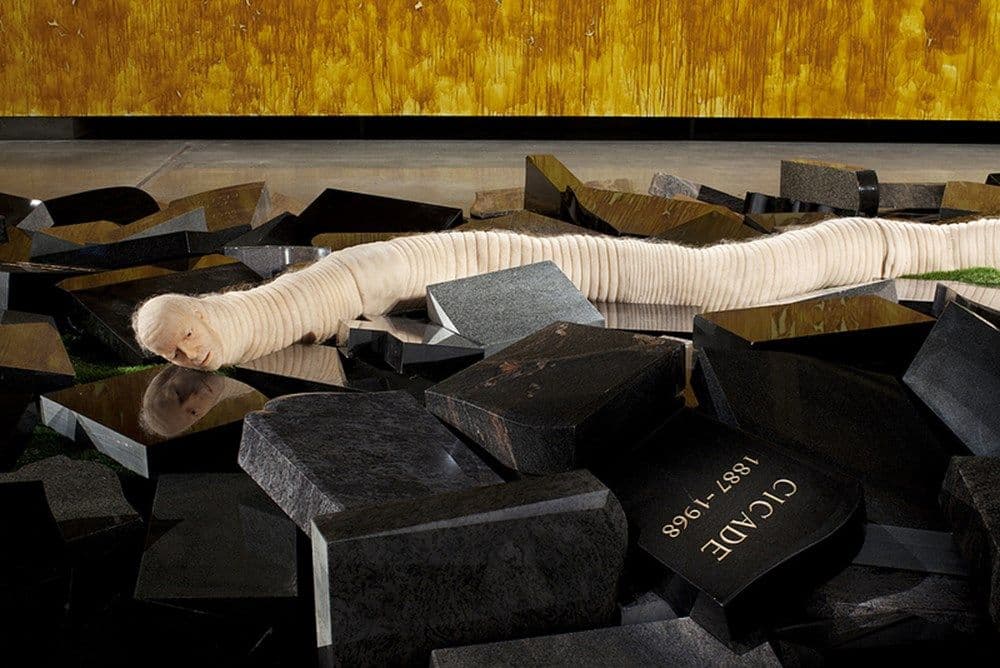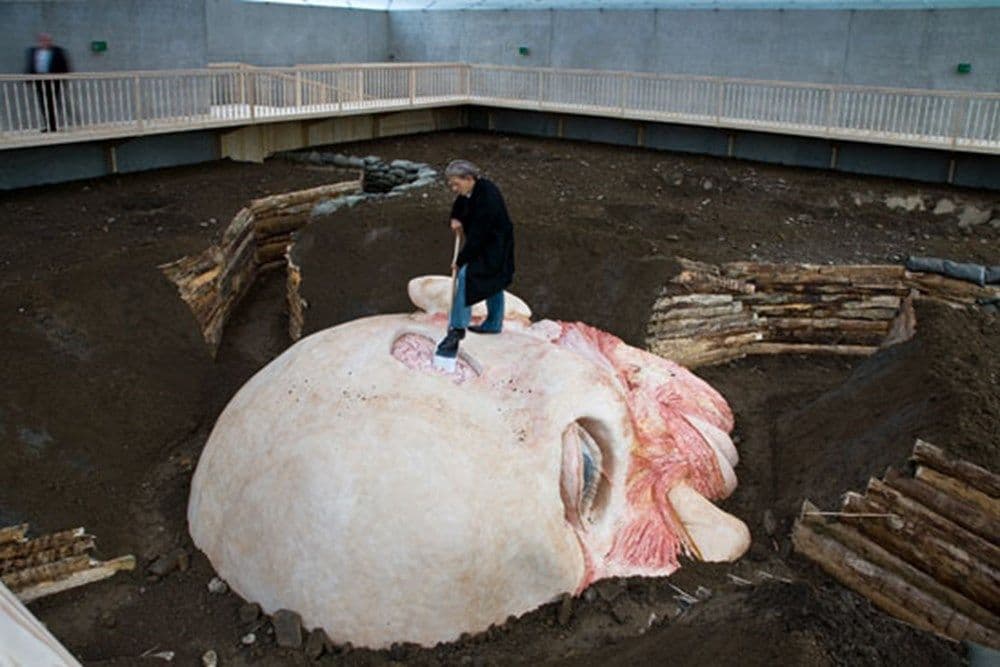At the arsenale
This worm bears the face of its creator, Jan Fabre. What the worm says is: ‘I want to draw my head out of the hangman’s rope of history’. He says it in Flemish, because the artist is from, um, Belgium. He’s a bit of an artist rock star, making major works for biennales and staging sell-out shows at the Queen Elizabeth Hall in London, that sort of thing.

Zelfportret, als grootste worm van de wereld, 2008
Jan Fabre/Licensed by Viscopy Copyright, 2012
I saw a work of his at the Venice Biennale (I just want to say: that sounds really snazzy, and part of me rejoices that I’m so lucky to have been to Venice as part of my job, but another part remembers that I was intensely lonely at that particular time, and found traipsing around the obviously incredible, amazing etc. Venice on my own, in the shoulder season, abjectly depressing). Fabre’s work was out in the boat-building part of town, called the ‘arsenale’ (hot and dusty. I went back to Venice two years later with my boyfriend, and with David and Kirsha – a far pleasanter trip, although my boyfriend and I did have a massive argument, or rather, I sulked in a very energetic manner, because at dinner one night David had commented that he found Brazilian-waxed women ‘hot’ and my boyfriend agreed with him, and I was mortally offended because I find the whole thing a form of casual self-torture that everyone seems to be participating in except me1; but more than that, I took it as a form of personal rejection, basically his way of saying, ‘Haven’t you realised by now I find you repulsive’. It was early in our relationship and perhaps, in hindsight, I was being a little sensitive. Anyway, on this far-pleasanter trip to Venice my boyfriend took photos wildly of the arsenale, the big cranes and chains and docks and stuff like that. I guess he was imagining the hub of empire. I was thinking more about Shakespeare). So the Jan Fabre work that I saw (this is the lonely trip now, the first) was encased in a large closed-in space around which the visitor walks via a sort of elevated, wrap-around viewing platform. You look down into this pit-like mound of dirt or soil or something, where a silicone replica of the artist stands digging into an oversized – perhaps, Nissan Micra-sized – replica of his own head. So it’s a big Jan head, over which a normal-size Jan stands and digs with a shovel. Parts of his big brains are exposed.

From the feet to the brain, 2009, Jan Fabre
What I’m trying to say is that this artist is pretty interested in excavating his own mortality. It’s a back-handed form of massive-egoism: an artist like Jeff Gabel – whose work flanks the worm in our gallery – isn’t obsessed with his own insignificance because it comes as less of a shock. It’s less of an affront, or insult to his intelligence. I’m siding with Jan here. I get weak-kneed shock each time I think about the fact that I’m going to one day not exist, but I’ve banged on about that enough by now. Maybe one day, the thought will begin to bore me. As an aside: Vladimir Nabokov’s autobiography, which I read (some of) in preparation for writing some marketing material for our concert Synaesthesia (Nabokov was a synaesthete) begins like this:
The cradle rocks above an abyss, and common sense tells us that our existence is but a brief crack of light between two eternities of darkness.
See also: ‘They give birth astride of a grave, the light gleams an instant, then it’s night once more…’ – Becket, Godot. Nabokov continues:
Although the two are identical twins, man, as a rule, views the prenatal abyss with more calm than the one he is heading for (at some forty-five hundred heartbeats an hour). I know, however, of a young chronophobiac who experienced something like panic when looking for the first time at homemade movies that had been taken a few weeks before his birth. He saw a world that was practically unchanged – the same house, the same people – and then realized that he did not exist there at all and that nobody mourned his absence. He caught a glimpse of his mother waving from an upstairs window, and that unfamiliar gesture disturbed him, as if it were some mysterious farewell.
That ‘young chronophobiac’, surely dead by now, was probably fairly self-centred.
Anyhow, the additional factor, of course, is that this worm work is not just about mortality, but about art and its history. Jan knows he is but a worm before the greats of European culture, whose names are emblazed (via some sort of entomological code) on the tombstones over which the worm debases himself (ok, that was a little dramatic, but still). Like all great egoists, this artist knows his place and is horrified.
I have felt some sort of Shakespearean reference agitating at the edges of my memory in relation to that work; if that sounds a little pretentious, perhaps you’ll like me more if I tell you the reference finally emerged (as in, just then, as I wrote the last paragraph) via my memory of a scene in a cemetery from the Steve Martin film LA Story (it’s got Sarah Jessica Parker in it and it’s brilliant). In this scene, the guy from Honey I Shrunk the Kids is grave-digging, and the actor playing Steve Martin’s love interest starts quoting Hamlet:
A fellow of infinite jest…
He hath borne me on his back a thousand times.
Where be your gibes now?
Your flashes of merriment that were wont to set the table on a roar?
I think what I’m saying is that Jan Fabre, like Steve Martin and everyone else, knows everything is shit compared to Shakespeare. Except maybe Nabokov.
The other encounter I had with Jan Fabre (other than when I interviewed him and he told me he felt sorry for the people who had to listen to my interviews, no joke) was when Olivier, Mona curator, took me to one of his said shows at Queen Elizabeth Hall, called ‘Orgy of tolerance’. It was during my first term as a Mona employee, and Olivier hadn’t quite worked out whether I had been sent to London as ‘a spy’. He took me to the show and I didn’t like it at all, although everyone else sure did. There was an extended group masturbation scene that transposes polite conversation with flagrant flogging of logs and so forth, which everyone but me found uproariously funny. Anyway it turns out Olivier was angling to bring the show to Tasmania for Mona Foma, and my reply to an email question from David – ‘Did you like the Jan Fabre show?’ – that no, I didn’t, I thought it was tacky and unfunny, contributed somewhat to David’s decision to can it. Olivier didn’t speak to me for a week. But when he did, his rage scorched my eyelashes. As it turns out I think David would probably have loved the Fabre show: he loves Balletlab, which similarly, I can’t stand.
One of the things Fabre said to me in the I-feel-sorry-for-your-listeners interview was that he believed in the ‘sacred bond’ between artist and viewer. He ‘trusts the public’, he says, to interpret his message and appreciate his creation, which we should not ‘dirty too much’ with our comments and interpretation. Whoops.
1 ‘But absolutely everybody gets Brazilians’ - My beautician, the other day.